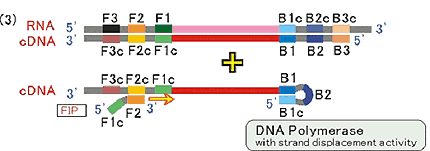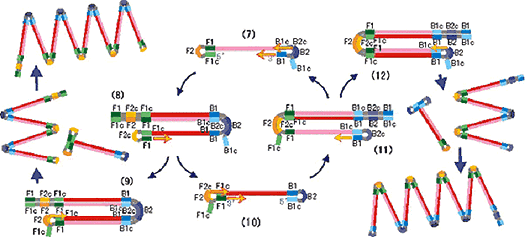- TOP
- About LAMP
- RT-LAMP method
RT-LAMP method
About RT-LAMP method
RT-LAMP (Reverse Transcription-Loop-mediated Isothermal Amplification) method can synthesize cDNA from template RNA and apply LAMP technology to amplify and detect them.
As the template is RNA sample, in addition to the reagents of DNA amplification (primers, DNA polymerase with strand displacement activity, substrates, etc.), reverse transcriptase is added to the reaction mixture. After mixing and incubating at a constant temperature between 60-65°C, amplification and detection can be carried out in a single step.
Design of primers
The U (Uracil) on target RNA sequence will be transcribed into T (Thymine). And similar with LAMP method, 4 primers can be designed to recognize the 6 distinct regions.

Principle of RT-LAMP method
Process of reverse transcription
STEP1
Use RNA extraction kit to extract RNA from the samples, and then prepare the sample solution. Mix the sample solution and the reaction solution and incubate them at a constant temperature between 60-65°C. As shown in the following figure (1), BIP anneals to the template RNA, and with the activity of reverse transcriptase, cDNA is synthesized.

STEP2
B3 primer anneals to the region outside of the BIP, with the activity of reverse transcriptase, a new cDNA is being synthesized, while concurrently releasing the cDNA strand previously formed by the BIP.

STEP3
From step (2), the single stranded cDNA synthesized from BIP is released. The FIP then anneals to this single stranded cDNA.

Steps for starting structure formation
STEP4
From reverse transcription step (3), through the activity of the DNA polymerase with strand displacement activity, the 3' end of F2 region in FIP becomes the starting point to synthesize complementary DNA strand.

STEP5
F3 primer anneals to the region outside of FIP, and its 3' end becomes the starting point to synthesize while concurrently releasing the DNA strand previously formed by FIP.

STEP6
The DNA strand synthesized by F3 primer together with the template DNA strand forms a double stranded DNA.

STEP7
Since the FIP linked DNA strand, which was released in step (5), contains complementary sequences at both ends, it self-anneals and forms a dumbbell-like structure. This structure (7) becomes the starting structure of the LAMP cycling amplification.

LAMP cycling amplification steps
STEP8
The dumbbell-like DNA structure (7) is quickly converted into a stem-loop DNA by self-primed DNA synthesis, which unfolds the loop at 5' end to extend DNA synthesis. The BIP anneals to the single stranded region in the stem-loop DNA to start DNA synthesis in step (8) while releasing the previously synthesized strand.
STEP9
This released single strand forms a stem-loop structure at the 3' end because of complementary F1c and F1 regions. Then, starting from the 3' end of the F1 region, DNA synthesis starts using self-structure as a template, and releases BIP-linked complementary strand. Structure (9) is formed.
STEP10
The released BIP-linked single strand then forms a dumbbell-like structure as both ends have complementary F1 - F1c and B1c - B1 regions, respectively. This structure is the turn-over structure of structure (7).
STEP11
Similar to step (7), structure (10) proceeds self-primed DNA synthesis starting from the 3' end of the F1 region. Furthermore, the FIP anneals to the F2c region and starts synthesizing DNA strand. This FIP-linked DNA strand is released by the strand displacement of self-primed DNA synthesis. Accordingly, similar to step (7), (8) and (10), step (10) and (11) proceeds, and structure (7) is once again being formed.
STEP12
With the structure produced in step (9) (or step (12)), the FIP (or BIP) anneals to the single stranded F2c region (or B2c region), and DNA synthesis continues by releasing double stranded DNA. As a result of this process, various sized structures consisting alternately inverted repeats of the target sequence on the same strand are formed.
